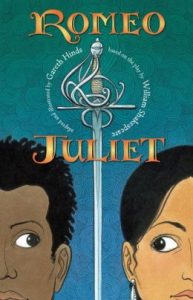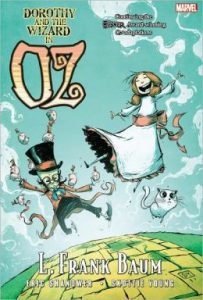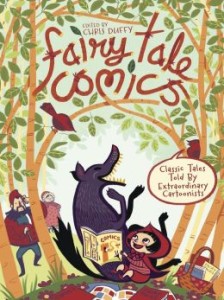We round out Picture-book month at Redeemed Reader with a look at some recent comic-book adaptations of enduring literary works–even though graphic novels, technically speaking, are not picture books, because the text in a graphic novel is as important as the pictures. In any case they’ve come a long way from their underground, cult-status days, getting more attention and respect. Many of them deserve it, such as
Romeo and Juliet, by William Shakespeare, adapted by Gareth Hinds. Candlewick, 2013,  128 pages. Age/interest level: 12-up.
128 pages. Age/interest level: 12-up.
Two households, both alike in dignity/ In fair Verona, where we lay our scene,/ From ancient grudge break to new mutiny/ Where civil blood makes civil hands unclean.
The “two households” are racially as well as uncivilly divided, though Hinds states in his introduction that he’s not making a statement about racial conflict so much as underlining the universal relevance of the story. The Montagues are African, the Capulets are Indian and Friar Lawrence adopts the robes of a Buddhist monk. Otherwise a Renaissance theme dominates, with all its color and pageantry and passion. The presentation of the story is faithful to Shakespeare’s original, with language intact though much truncated. This includes the sexual innuendo among the lackeys in the first scene, but young readers won’t necessarily notice that. They will notice Romeo getting dressed after his wedding night (while Juliet remains chastely gowned), but by the time they’re old enough to read a Shakespeare text, they’re also old enough to know what wedding nights are about. In the appendix the artist explains some of his interesting depiction choices (such as why he decks Tybalt in tattoos) and cites actual places in Verona that were used as settings.
Gareth Hinds is known for previous graphic adaptations of the classics, such as King Lear and Beowulf. Overall, Romeo and Juliet is beautifully done and an excellent introduction to the play. Shakespeare was primarily meant to be seen and heard, not read. If a live stage production can’t be had, a graphic novel adaptation makes a lot of sense.
- Worldview/moral value: 4 (out of 5)
- Literary/visual value: 5 (It’s Shakespeare, for heaven’s sake!)
 Dorothy and the Wizard in Oz, by L. Frank Baum, adapted by Eric Shanower and Scottie Young, Marvel, 2012, 184 pages. Age/interest level: 10-up.
Dorothy and the Wizard in Oz, by L. Frank Baum, adapted by Eric Shanower and Scottie Young, Marvel, 2012, 184 pages. Age/interest level: 10-up.
This title is the fourth in Baum’s original series, and according to Shanower’s introduction, the “darkest” of the lot. Our story begins when Dorothy and her cousin Zeb fall into a huge crack made by a California earthquake and drift all the way down to the glass city of the Mangaboos. The Mangaboos have no more heart than a rutabaga (because they’re actually people-shaped vegetables), but Dorothy & Company manage to escape to higher ground in the Valley of Voe whose inhabitants are invisible. Next they must climb the Pyramid Mountains, where the dragons seem awfully talky but have sharp teeth nonetheless, and the famed gargoyles are made of wood. It seems they’ll never get out from underground until Dorothy calls on Ozma, her good friend from previous adventures, who summons them all magically to Oz.
I could never get into the original Oz books—liked the movie version better. Baum had a lively imagination but, to my mind, little depth; the stories seem rambling and episodic and never make you care about anybody. But they do lend themselves well to graphic-novel treatment, and though there are several other graphic adaptations, Shawnower and Young, who have worked together on least five Oz books, are best at creating an appropriate sense of zaniness. I do like this brief exchange, which contains a little food for thought: (Dorothy) Oz is only a humbug wizard, though. (Ozma) That’s the safest kind of wizard to have.
- Worldview/moral value: 3.5
- Literary/visual value: 4
Fairy Tale Comics: Classic Tales Told by Extraordinary Cartoonists, edited by Chris Duffy. First Second, 2013, 123 pages. Age/interest level: 6-12.
Eighteen classic tales are retold in panels by established graphic artists. Some of the stories, like Little  Red Riding Hood and the Twelve Dancing Princesses, are well known. Others—Small Tooth Dog, Sweet Porridge, The Boy Who Drew Cats—are traditional folk tales from all over the world. One of my favorite stories, previously unknown to me, is “Give Me the Shudders,” about a youth who can’t be frightened. Speaking of fright, some of the tales are too scary for young children, like Baba Yaga the witch (I remember Baba Yaga comics from my own childhood—her chicken-footed cottage gave me the creeps). But there’s nothing really objectionable, though I’ll admit to being irritated by Gigi D. G.’s depiction of the hunter in Red Riding Hood as a lumberjack—no, a lumberjill, a female with upper-body development very unlikely in real life.
Red Riding Hood and the Twelve Dancing Princesses, are well known. Others—Small Tooth Dog, Sweet Porridge, The Boy Who Drew Cats—are traditional folk tales from all over the world. One of my favorite stories, previously unknown to me, is “Give Me the Shudders,” about a youth who can’t be frightened. Speaking of fright, some of the tales are too scary for young children, like Baba Yaga the witch (I remember Baba Yaga comics from my own childhood—her chicken-footed cottage gave me the creeps). But there’s nothing really objectionable, though I’ll admit to being irritated by Gigi D. G.’s depiction of the hunter in Red Riding Hood as a lumberjack—no, a lumberjill, a female with upper-body development very unlikely in real life.
Younger kids will enjoy the stories, but a particular value of this volume for older readers is the handy compilation of drawing styles and storytelling techniques. An aspiring artist or graphic novelist could learn a lot from making comparisons and thinking through the artistic choices. And here’s a heads-up for those aspiring artists in your family: come back tomorrow for some how-to books.
- Worldview/moral value: Neutral
- Literary/visual value: 5
We’ve looked at lots of graphic novels in the past: be sure to click the Beowulf link above, and Betsy’s review of the most celebrated title(s) of the year, Boxers and Saints. Doug TenNapel is a great example of contemporary graphic storytelling: see our reviews. Finally, if you’re tempted to buy The Brick Bible as a gift for your favorite Lego-lover—don’t.
Support our writers and help keep Redeemed Reader ad-free by joining the Redeemed Reader Fellowship.
Stay Up to Date!
Get the information you need to make wise choices about books for your children and teens.
Our weekly newsletter includes our latest reviews, related links from around the web, a featured book list, book trivia, and more. We never sell your information. You may unsubscribe at any time.
We'd love to hear from you!
Our comments are now limited to our members (both Silver and Golden Key). Members, you just need to log in with your normal log-in credentials!
Not a member yet? You can join the Silver Key ($2.99/month) for a free 2-week trial. Cancel at any time. Find out more about membership here.
2 Comments
Leave a Comment
You must be logged in to post a comment.


This quote from Fairy Tales and After: From Snow White to E. B. White by Roger Sale, not a book with which I generally agree, nicely sums up Baum’s artistic limitations, I think.
“The essence of Baum is his careless ease, his indifference to the complexities of life, his eagerness to describe what enchanted him without ever exploring or understanding it. Such people often become entertainers of one sort or another, but they seldom become writers. It might be said he had a knack for writing the way some people have a knack for singing or dancing or hitting a baseball. He obviously enjoyed writing but his view of himself as a pleaser of audiences and his indifference to any disciplining of his genius meant he often wrote a good deal he didn’t want to write.”
I never got into the Baum books. I guess that’s why.